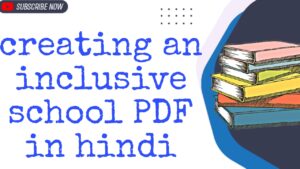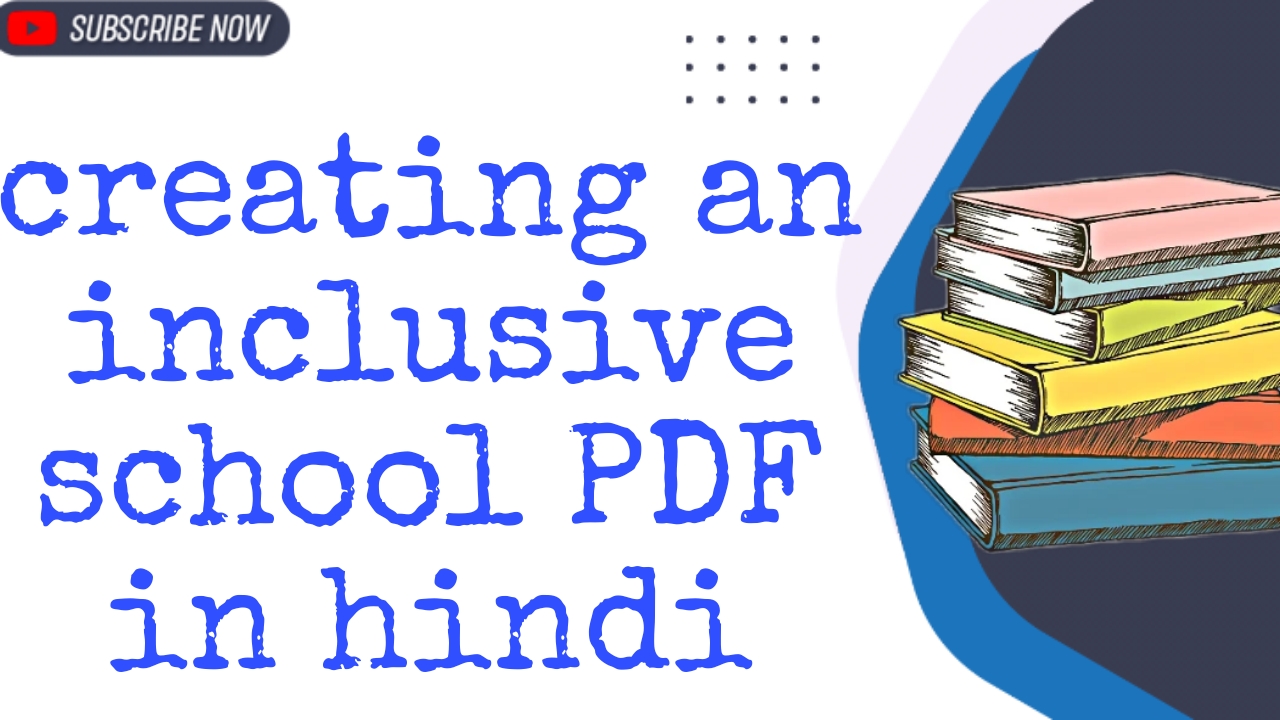creating an inclusive school PDF in hindi:समावेशी स्कूल बनाना
creating an inclusive school PDF in hindi 2023- Hello friends welcome to our blog and in this post you will see that the creating an inclusive school pdf in tamil, creating an inclusive school notes and, creating an inclusive school b. ed pdf
Table of Contents
creating an inclusive school b. ed notes pdf in hindi
Course Material for B. Ed (Second Year)
Course 10: Creating an Inclusive School
Prepared by Understanding the disability
Policies and programmes of inclusive education
INTRODUCTION
Education is the fundamental right of every child. Sufficient opportunities should be
provided to the child in education. Based on this, Educational opportunities for special children are also stressed in our country. Swami Vivekananda emphasizes “If special children are unable to move towards education, the education should go towards them”.
creating an inclusive school in hindi notes PDF 2023
COURSE 10: CREATING AN INCLUSIVE SCHOOL
After the completion of the unit, the learners will be able to:
1. understand the disability
2. explain the characteristics of disability
3. classify the different types of disability
MEANING AND DEFINITION OF DISABILITY
Disability is defined as “any restriction or lack (resulting from an impairment) of ability to perform an activity in the manner or within the range considered normal for a human being”.
Disability is a condition or function judged to be significantly impaired relative to the usual standard of an individual or group.
Impairment is the loss of an organ or the defect in structure and function of the organs of a person. This defect may be temporary or permanent.

creating an inclusive school b. ed notes pdf in english
DIFFERENCES BETWEEN DISABILITY AND IMPAIRMENT
IMPAIRMENT
Any restriction or lack (resulting from an impairment) Any loss or abnormality of
of ability to perform an activity considered normal for psychological, physiological
a human being. or anatomical structure or
function
Disability results from impairment, limiting the range May be genetic; may occur in
and efficiency of one’s functioning. developmental stages or may be due to accidents, diseases etc.
The degree of disability could be reduced with the use Once impairment occurs, it
of equipments and appliances. cannot be completely rectified.
creating an inclusive school b. ed notes ppt
CHARACTERISTICS OF DISABILITIES
1. Due to loss or abnormality of physical organs. (e.g.) mal-formation of limbs, cleft lip. disfigured fingers.
2. Disorders due to dysfunctioning of organs of the body eventhough they may have normal anatomical structure.
3. Impairment of organs of the body.
4. Due to genetic disorders, developmental defects, accidents or diseases.
5. Due to the limitation of one’s functioning arising from impairments.
6. Due to the inability to undertake activities of daily life like others. ie. one’s functional
efficiency getting affected.
7. The degree of disability could be reduced with the use of appropriate equipments and appliances.
8. The handicap arising out of disability could be greatly reduced by providing appropriate opportunities and facilities in the society.
9. Rehabilitation could be provided to the disabled by offering proper educational climate and exercise.
10. Without motivation and exercise, the degree of disability is likely to increase.
CAUSES OF DISABILITIES
Genetic Disorders
Severe Malnutrition
Diseases(Polio, Paralysis, Brain fever, cerebral palsy etc.)
Adverse effects of drugs consumed during pregnancy
Artificial fertilization
Problems during delivery
Severe accidents
creating an inclusive school PDF in hindi
HEARING IMPAIRMENT
INTRODUCTION
Among the five sense organs, Ear is not only responsible for tactile sensation but also paves way for awareness in the environment. Also it helps to learn a language and the skill of speaking it.
When one loses his hearing capacity he is unable to adjust & face problems in the society. Hearing is defined as the reception of the environmental sound, knowing the properties of the sound & by
whom it has been made. Defect in listening and understanding the conversations is called listening disability. It affects the natural growth of the children and behavior. Especially is affects hearing.
speaking and understanding abilities. Hearing impaired children face more difficulty in hearing.
speaking and communicating with others. These children have less speaking skills.
creating an inclusive school pdf bharathidasan university
TYPES OF HEARING IMPAIRMENT
> Hearing impairment has three types. They are.
> Conductive loss happens in the External cars.
> Sensory neural hearing loss, it happens due to the defects in the nerves, Ear drums and
bones in the internal car
> Mixed hearing loss is a combination of conductive and sensory neural hearing loss
The defects occur in Internal and external ears Audiometer is used to identify these types of defects. This type of measuring is called Audiogram. The unit of sound is mentioned as Decibel
SYMPTOMS OF HEARING IMPAIRMENT
1. Non-response (shock) of the child for loud clapping within 3 feet
2. Unable to turn towards the direction of the sound
3 Delay in understanding
4. Insist the teacher to repeat the taught units.
5. Keen observation of the facial expressions of teacher, while talking
6. Very low level skills in Listening and Understanding
7. More stammering while speaking and very poor in reading.
& Bend head to listen to the side of speakers.
9. Differences in voice, sound and pronunciation
10 Non-responding while calling
11. Disinterested in listening to stories.
12 Leakage of pass from ears.
13 Seek others help when teacher dictates in the class.
REASONS FOR HEARING IMPAIRMENT
1. Genetical factors (Related to Genes).
2. Non Genetical factors (unrelated to Genes).
GENETICAL FACTORS
> Warden perk Syndrome: One who has this syndrome should marry another person with this syndrome to deliver a normal child without this hearing impairment. Otherwise there are more chances for the birth of hearing impaired babies.
>Close relationship marriage.
> Genetic defects.
Genes Aberrations
NON-GENETICAL FACTORS
➤ Chicken Pox.
> High fever e.g. Flu fever, Dengue fever
> Inflammation in inner ear during accident.
> Defects in the ear-brain nerves.
> Brain injury disturbing the growth of language skill
> Exposure to loud noise
> Nerves problem in old age.
> Jaundice during pregnancy.
> Mal- Nutrition during pregnancy.
HEARING DEVICES FOR HEARING IMPAIRED CHILDREN
> Horn, calling bell, Flute, Drum
➤ World map and Globe.
➤ Cartoons.
> Colour Pictures.
Hearing Aids, Materials.
➤Mirror.
Speech Box
Music dolls.
> Audiometer.
> Text to speech
➤ Audio Books.
> Individual hearing devices & group hearing devices.
WAYS OF ATTAINING SUCCESS FOR HEARING IMPAIRED PERSONS
Identify the hearing impaired in the early childhood and provide suitable hearing aids
Practice them to observe the various sounds in their surroundings. Hearing impaired people can lead a normal life in the society. This idea is to be developed among the teachers & parents. Engage the parents in activities that increase the speaking skill of the hearing impaired students Creating awareness among the parents and people & enable them to think, that they can also lead a normal life like the other children of their age
ROLE OF TEACHERS IN TEACHING THE HEARING IMPAIRMENT
1. The Hearing impaired children must have a good view of the teacher in the classroom. A good rapport between the teacher and the students is to be maintained
2. The teachers must look at the faces of these students while teaching, so that they follow the lip movement and the gestures of the teachers
3. The teachers should use more teaching learning materials; especially more visual
pictures are to be used.
4. More training for speaking skills should be given.
5. While teaching new lessons, real objects must be used
6. More reading practice is given to the learners


